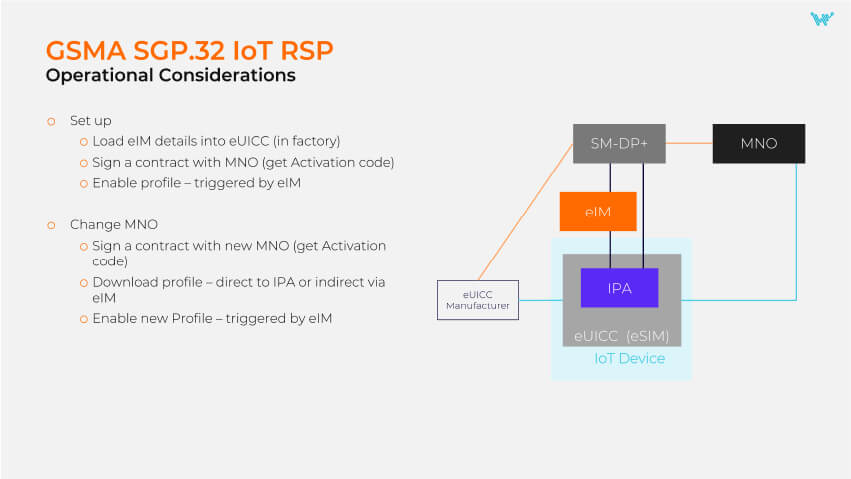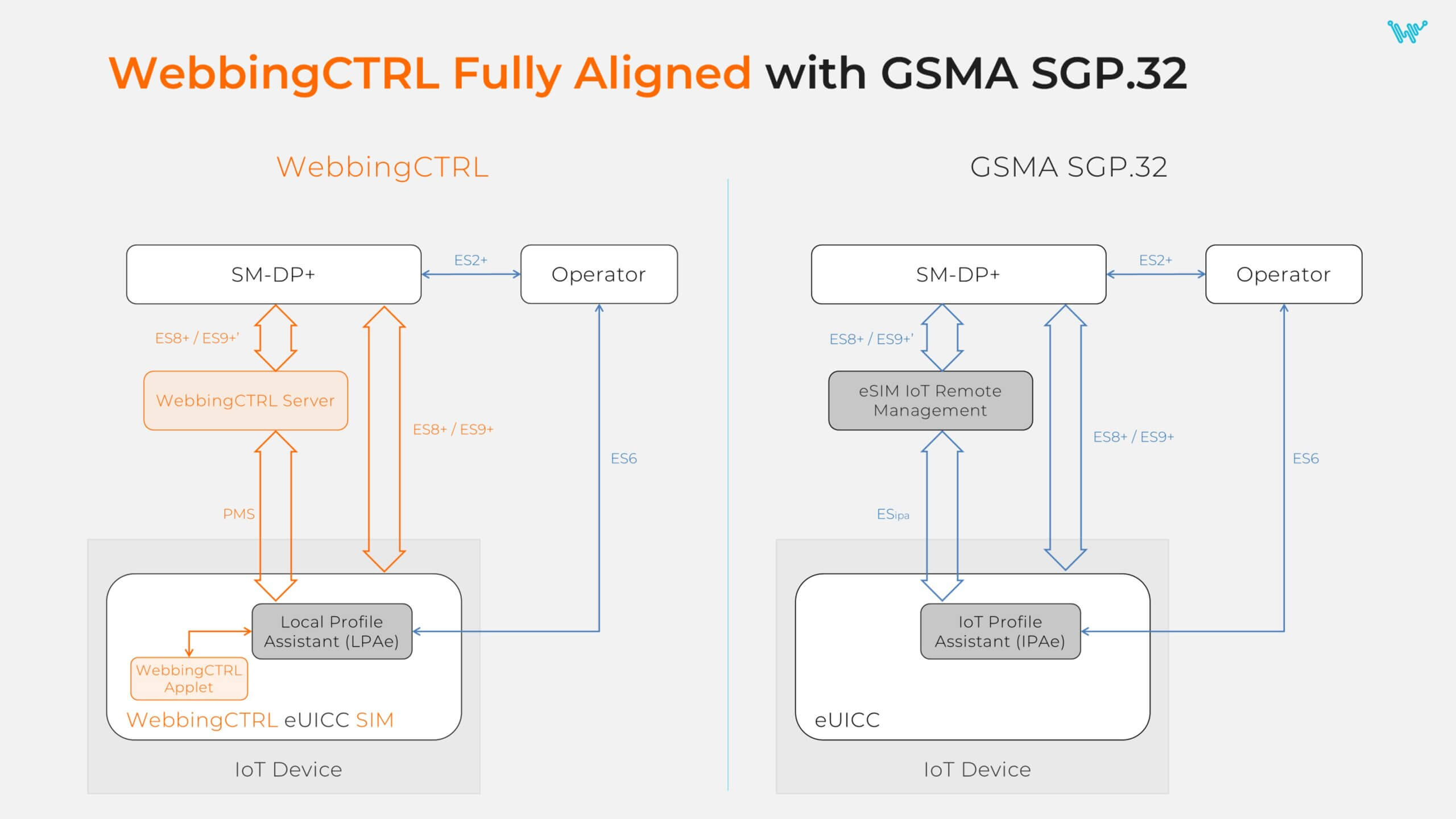The new RSP standard explained, its market status, expert forecasts,
and practical next steps
by Baruch Pinto | November 11, 2025
In multiple posts over the past several years, we’ve covered SGP.32 and why it matters. In our biannual Chronicles, we’ve also tracked progress on the new GSMA remote SIM provisioning standard. With the specification now stable and full-scale commercial use set to gather pace, here’s where things stand.
What Is SGP.32
SGP.32 is the new GSMA remote SIM provisioning (RSP) standard for IoT devices.
SGP.32 allows to remotely download, enable, disable and delete carrier profiles on an eSIM without any technical integrations between network operators.
The new standard is a major milestone for the industry, because it simplifies IoT connectivity, reduces the time to market for IoT deployments, boosts eSIM adoption and growth of connected device use. It is designed specifically for network constrained and user interface constrained devices, and effectively overcomes the hurdles that existed with previous RSP standards. We explained the difference between SGP.32 and two previous GSMA RSP standards, SGP.02 and SGP.22, in more detail here.
SGP.32 enables enterprises that deploy IoT devices to easily switch connectivity providers or have a multivendor connectivity provider strategy, solving multiple problems such as vendor lock-in, multiple SKUs for various markets, or hassles of compliance with local connectivity regulations in certain countries. It also helps them manage large volumes of profiles and queue profile operations easier.

How SGP.32 Works
SGP.32 architecture includes several key elements:
- SM-DP+ (Subscription Manager – Data Preparation + Secure Routing), the server that securely packages, encrypts, and delivers operator profiles to an eSIM.
- eSIM IoT Remote Manager (eIM), the server-side controller that coordinates with devices’ IPAs and SM-DP+ to securely discover, download, activate, deactivate, and manage eSIM profiles on the eUICC or multiple eUICCs.
- IoT Profile Assistant (IPA), the lightweight on-device software that securely talks to the eIM to download, enable, disable, and manage eSIM profiles on the eUICC.
Using these elements, SGP.32 allows to perform remote “SIM swaps” in fleets of devices with eSIMs (eUICC). The eIM decides which device should use which carrier profile and when. When you want to change carrier or add a plan, your eIM asks a profile server (SM-DP+) to prepare the new operator profile. Then the eIM instructs the device’s IPA to securely fetch, install, and enable it on the eUICC.

SGP.32 Status & Readiness
Published by the GSMA in May 2023, SGP.32 was expected to become available for use at the end of 2024, as it needed some time to complete the related test specifications and compliance programs. However, progress took a bit longer than expected and it wasn’t finished until the first half of 2025.
Today, there’s a lot of work happening around the SGP.32 ecosystem. With the core specification finalized, and all testing and verification finally done, vendors can officially get through the certification process for all key elements of the architecture: the eUICC, the DP+ and the IPA. There is no standalone GSMA Compliance listing required for the eIM, but most of the eIM vendors still go through a certification process.
Starting from April 2025, vendors began announcing certifications that demonstrate functionality and interoperability, some claiming full-stack solution compliance, some only for an eUICC component. Some also announced compliance with eSA (security assurance) and SAS-SM (site security), which are security schemes that are adjacent to GSMA eSIM Compliance. With early commercial use just starting, broader rollout is underway: for example, in September, Transforma Insights mentioned a provider working on a 1m+ connections customer that wanted to make use of SGP.32.

Expert Expectations
A year ago, with standardization nearing its end, ABI Research forecast the number of eSIM SGP.32 profile downloads to grow rapidly from 2.9 million downloads in 2025 to more than 194 million downloads in 2029. Because of delays in SGP.32 implementation, in their 3Q 2025 report they had to adjust expectations for 2025, and the resulting jump in IoT deployments is expected to be seen primarily in H2 2026 and scaling through 2027.
In April, Kaleido Intelligence forecast around 50 million SGP.32-compliant eSIMs to be managed globally by 2027. Researchers specifically noted that the nascent state of the SGP.32 ecosystem meant a long road ahead in terms of testing, interoperability, and solutions to reduce complexity, and that the interaction between different OSs, devices and eIMs has yet to be tested on a broad scale.
In September, another new Kaleido Intelligence report was quoted in the media, stating that SGP.32 solutions are being tested now, with a view to a commercial acceleration through 2026, and a tipping point sometime in 2027-2028. The compound annual growth (CAGR) in the period to 2028 for IoT SGP.32 eSIMs was forecast at 240 percent (4.9 million, today, to 192.8 million).
With all these promises of future growth, while the ecosystem around SGP.32 is still forming, enterprises that need tried and tested connectivity solutions for their IoT deployments may prefer to wait until there are enough certified products and successful implementations. However, there is an option of using proprietary pre-standard solutions compatible with SGP.32 requirements. There are solutions that have already been thoroughly tested and commercially deployed, such as WebbingCTRL, which successfully ensures over 1 million connections across various industries. These solutions can help enterprises reap all the benefits of the new standard and prepare for seamless migration to SGP.32 when it becomes ubiquitous. The solution architecture will be the main differentiator here, as it will be critical for compatibility and seamless transition to the new standard.
Experts also note that although SGP.32 is a very powerful tool, there is more to providing connectivity than just enabling switching between eSIM profiles, and that’s where additional capabilities often grouped under the term “eSIM orchestration” become essential. While eSIM provisioning allows to remotely download and activate mobile profiles on devices, eSIM orchestration goes further by adding automation and logic layers.

WebbingCTRL
Our eSIM solution, WebbingCTRL, ensures failover connectivity with the capability of using multiple mobile carrier profiles, easily changing carriers at any time with zero integration, and an option to fall back from a failing profile to a different profile without any need to communicate with a remote server. Webbing’s eSIM is aligned with the GSMA SGP.32 IoT eSIM specification, which means it is fully compatible with the new standard.
Our solution’s architecture is similar to that of SGP.32. Just like with the new GSMA IoT standard, remote provisioning with WebbingCTRL does not require any operator integrations or collaborations. It enables organizations to remotely add, remove, and swap carriers for any number of IoT deployments.
Along with all the functionalities of the new standard, WebbingCTRL has additional capabilities: companies can set up business rules that would allow devices to change the serving operator automatically under specific conditions, such as location, country, loss of connectivity or even after a certain amount of time. It also provides a centralized way to manage eSIMs/SIMs lifecycle and profile inventory, as well as visibility into device data usage.
Long before the work on SGP.32 was finished, Webbing aimed to provide device owners with tailor-made and future-ready connectivity under their control. Many of the elements now associated with eSIM orchestration – device onboarding, management platform, tailored connectivity offering, consistent client support — have long been core parts of Webbing’s solution.
Reach out to learn more about WebbingCTRL and our eSIM orchestration capabilities.




